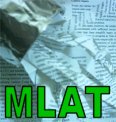

|
MLAT : a set of natural language processing tools in OCAML |

let dico = new dictionary range default_parameters;; dico#add_to_forget_list file_name;; dico#add_source stream_name optional_parameters;; dico#info;; (* to get some informations *) dico#add_source stream_name optional_parameters;; (* to add another source *) dico#quantify forget_levels;; dico#info;;and to quantify the corpus :
dico#set_feature_space final_dimention internal_dimension;; dico#component_cloud format projective_dimension;; (* to get informations, format is in ASCII|XML|HTML|ASCII4MAT *) dico#sources_cloud format projective_dimension;;or in a more advanced version to produce automatic clustering :
dico#learn_supervised_clustering new_key flags_set1 flags_set2 algorithm;; (* to clusterize set1 vs set2 *) dico#learn_info new_key;; let k = dico#add_source stream_name optional_parameters;; dico#clusterize key set_of_source_keys;;or to provide unsupervised clustering with something like :
dico#learn_clusters new_key set_of_source_keys;; (* or replacing set_of_source_keys by set_of_flag_keys *) dico#learn_info new_key;; let k = dico#add_source stream_name optional_parameters;; dico#clusterize key set_of_source_keys;;some friends already asked me to be able to compute distances like in :
let d = dico#distance_bewteen source1 source2;; let k = dico#closest_to source;;
VERSION 0.1 - load it into OCAML with #use "MLAT.ml"
this is a site by CAL